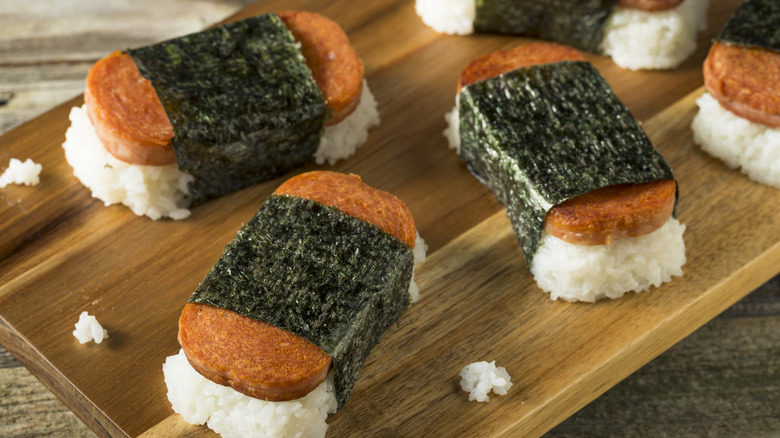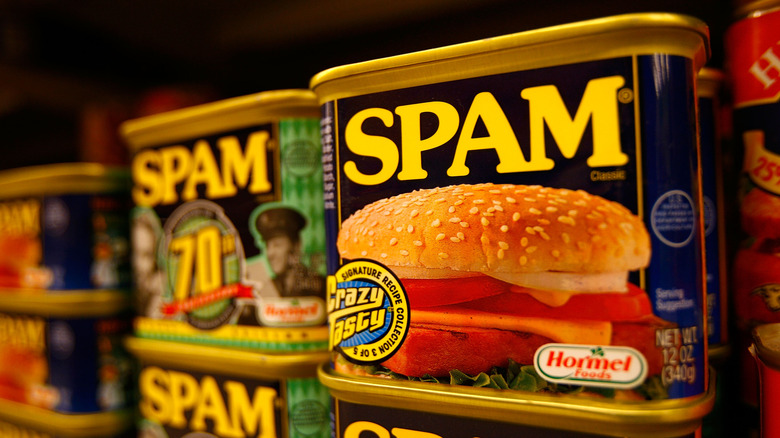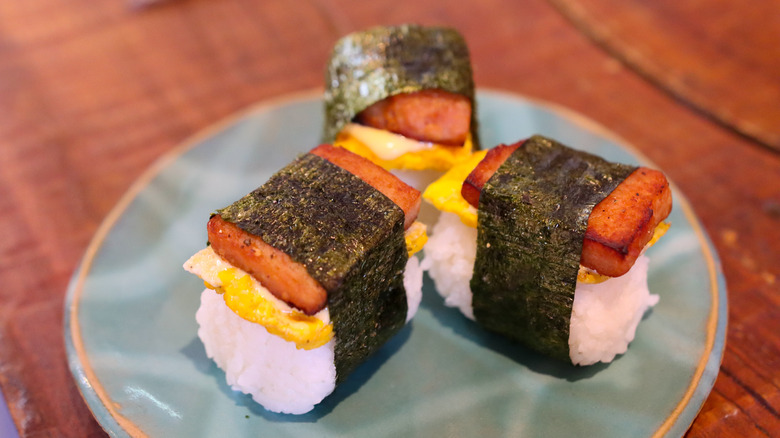Why Spam Musubi Is Such A Popular Snack In Hawaii
If you've visited Hawaii, you may have noticed that there's a surprising amount of food centered around Spam (that is, the canned pork shoulder and ham product). In fact, the state consumes some 7 million tins of the iconic luncheon meat per year among a population of around just 1.4 million residents. While there are lots of ways to take Spam to the next level, many in the Aloha State enjoy it as musubi: sliced and pan-fried, then tucked into roasted nori seaweed alongside a hunk of rice in a way that resembles sushi. Before wrapping, the Spam is typically seasoned and cooked with sauces and other ingredients to boost its flavor.
Spam musubi is considered a staple snack food in Hawaii, but its origin story is hard to pin down. However, it's generally agreed that Spam became a big part of Hawaiian cuisine around World War II, just a few years after the canned meat product first hit the shelves in the 1930s. The official line from Hormel Foods (the company that produces Spam) is that soldiers were eating it during wartime, at which point it crossed over and became popular among the general population. However, it wasn't a constant part of military rations, and many non-GIs likely ate it during the war as part of food rationing programs, for which Spam is an obvious candidate due to its long shelf life. Plus, with Hawaii so far from the continental United States, it had reduced access to other foods.
Spam musubi's birth as a fusion dish
So, if the war is how Spam entered Hawaiian cuisine, what about Spam musubi specifically? Its creation is not completely agreed upon, but it tends to be credited to a Japanese-American woman named Barbara Funamura, who may have cobbled it together based on whatever ingredients were available to her at the time, including predominantly Japanese seasonings like soy sauce and mirin. Some recipes will call for oyster sauce (although it's of Chinese origin), rice vinegar, and/or furikake, a Japanese seasoning similar to other umami-packed toppings made with nori that often includes dried seafood (often added to the rice). Depending on how it's cooked, the Spam can end up richly glazed and resembling teriyaki (sugar is commonly included to help with caramelization).
Another theory is that spam musubi was created in internment camps where Japanese-Americans were held prisoner, considering that Spam was one of a limited number of foods they had on hand. In any case, it indisputably arose from Japanese-American culture. Perhaps because Spam was so prevalent in Hawaii during the war, it shed its reputation as an undesirable processed meat, becoming normalized in Hawaiian cuisine. As a result, Spam musubi didn't suddenly get popular at one particular moment or for one particular reason (beyond the popularization of Spam in Hawaii), but rather, it gradually evolved into a common snack; with such a large Japanese population on the islands, Hawaiians were likely primed to gravitate towards the ingredients in Spam musubi.
How Spam musubi is evolving
The beauty of Spam musubi is that it has fans in convenience stores as well as the professional culinary world: "Top Chef" fan favorite Sheldon Simeon, who owns casual counter spot Tin Roof on Maui, likens it to the Japanese seaweed-wrapped rice snack onigiri. In a video for Munchies on YouTube, Simeon argues that you don't need to be perfectly faithful to the "traditional" recipe. He notes that you can add other meats like Portuguese sausage or make your own furikake.
Furthermore, thanks to Hawaiian chefs, the dish has started to get a foothold in the continental United States. To name just one, chef Chung Chow serves several versions at New York City restaurant Noreetuh, including Spam musubi with either cheese or kimchi, or pickled jalapeños. In conversation with the University of Hawaii, he described what he offers as "a more luxurious option." Variations on the classic seem to be common when it's served in the lower 48. For example, San Francisco café Avenues offers salmon and tofu versions of it.
It's worth noting that Spam (and, by extension, Spam musubi) isn't universally loved in Hawaii. As a heavily processed food, some people shun it in favor of local, fresher ingredients. It's also not unheard of to find chefs attempting to make their own Spam, in some cases, with higher-quality organic pork. Generally speaking, though, canned Spam is inordinately popular, and Spam musubi is arguably the most iconic dish to feature it.


